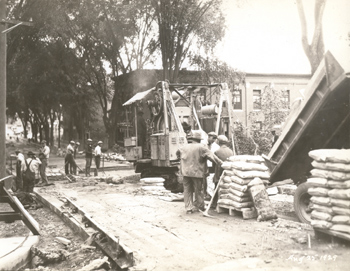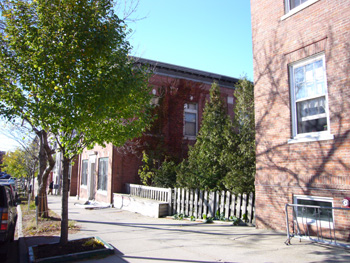


 |
 |
Date: August 25, 1929 |
Date: October, 2006 |
Looking Towards 206 College Street |
Geographic Position: 180642385E 4926459N |
This photograph shows the extensive reconstruction along College Street. In 1929, the project on College Street accomplished three things: replacement of the road surface, a reconstruction of the curbs, and the construction of 30” gutters. For the replacement of the road, a 2” layer of stone-filled-sheet asphalt was placed on top of a concrete base, which bears the load of the vehicles, 6” deep; the construction of the road cost a grand total of $6,000.46.[1] This particular photograph shows the curb reconstruction which was undertaken because water would flow down from the South Union Street and South Winooski Avenue intersections and create drainage problems on both sides of the street parallel to the Fletcher Free Library.[2] Heavy rain storms frequently caused the catch basins to become obstructed.[3] The excavated areas of curb and gutter were removed using a hand-shovel, which resulted in a significantly higher price than a similar North Winooski avenue project that used a power shovel in lieu of the hand-shovels.[4] In the forefront of the photograph, a Koehring 13-E concrete paver can be seen at work. In the lower left-hand side of the photograph, the forms for the construction of the curb can be seen. Visible in the photograph is 260 College Street. It was constructed in 1905 to house the New England Telephone Company. The majority of the eastern-façade is visible in the photograph. The Neo-Classical style is comprised of two stories and includes a raised basement which is obscured by the concrete paver.[5] The raised basement and first floor is separated by a course of granite with concrete bases supporting pilasters that extended the entire first and second floor. The side-façade windows are complete with keystone lintels.On the second floor, a fire escape door and stairs is hidden behind the construction equipment. As an interesting sidenote: In 1986, the son Vice Presidential Candidate Geraldine Ferraro, John Zuccaro, was arrested for selling cocaine to a police officer at Middlebury College. He was convicted in 1988 and scandal erupted when it became evident that he was serving his sentence at 260 College Street, not in the confines of prison.[6]
[1] City of Burlington, Vermont, Sixty-fifth Annual Report of the City of Burlington, Vermont: For the Year Ended December 31, 1929 (Burlington, VT: Lane Press Inch, 1929), 230. [2] Ibid. [3] Ibid. [4] Ibid, 231. [5] Ibid. [6] David J. Blow, Historical Guide to Burlington Neighborhoods: Volume II, ed. Lilian Baker Carlisle (Burlington, VT: Queen City Printers Inc., 1997), 23. |
206 College Street continues to be used as apartment building; it currently houses more than five separate apartment dwellings.[1] Evident is a section of the new YMCA building constructed in 1934. The YMCA's previous headquarters were located near the northeast corner of City Hall Park (at the corner of College and Church Street). On February 1, 1928, a fire of unknown cause destroyed the majority of the building. The new YMCA building, located at 266 College Street, was completed in December of 1934 and designed by Frank L. Austin of Burlington.[2] Unfortunately, gone are the stately American elms that once filled the College Street landscape; a variety of neatly planted trees stand in the elm’s wake. Also present are the now ubiquitous parking meters.
[1] City of Burlington, Assessor “206 College Street,” http://www.ci.burlington.vt.us/assessor/search/index [2] David J. Blow, Historical Guide to Burlington Neighborhoods: Volume II, ed. Lilian Baker Carlisle (Burlington, VT: Queen City Printers Inc., 1997), 23. |
Historic Burlington Project Depression Era Streetscapes: Old North End | Burlington 1890 | Burlington 1877 | Burlington 1869 | Burlington 1853 | Burlington 1830 Produced by University of Vermont Historic Preservation Program graduate students in HP 206 Researching Historic Structures and Sites - Prof. Thomas Visser - in collaboration with UVM Landscape Change Program Historic images courtesy of University of Vermont Library Special Collections, Louis L. McAllister Photograph Collection |